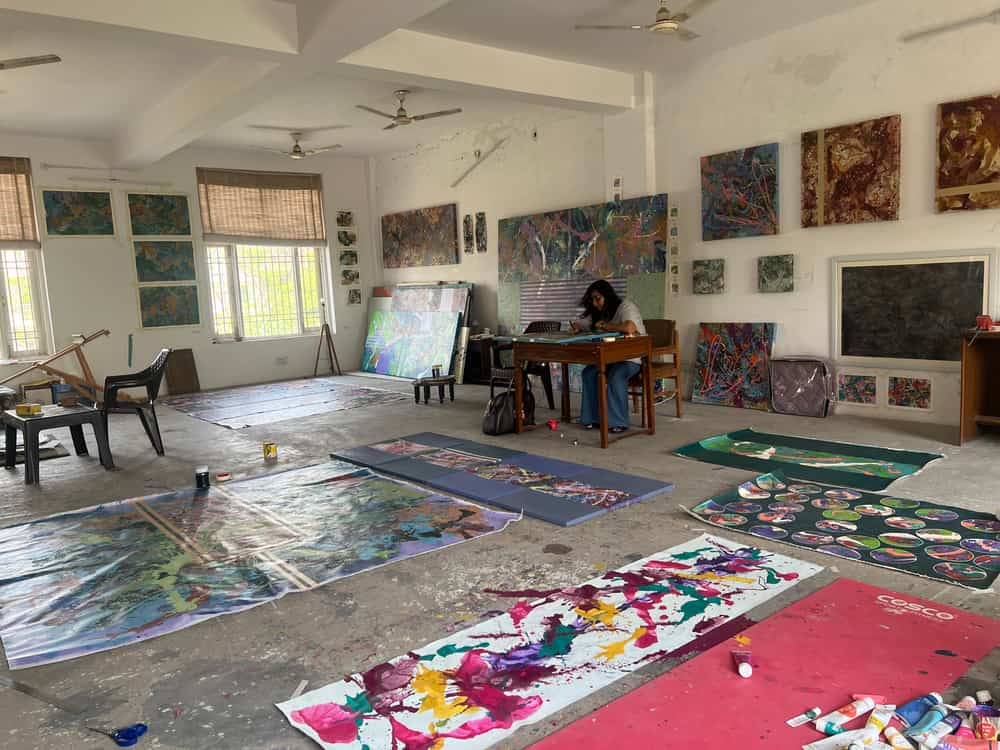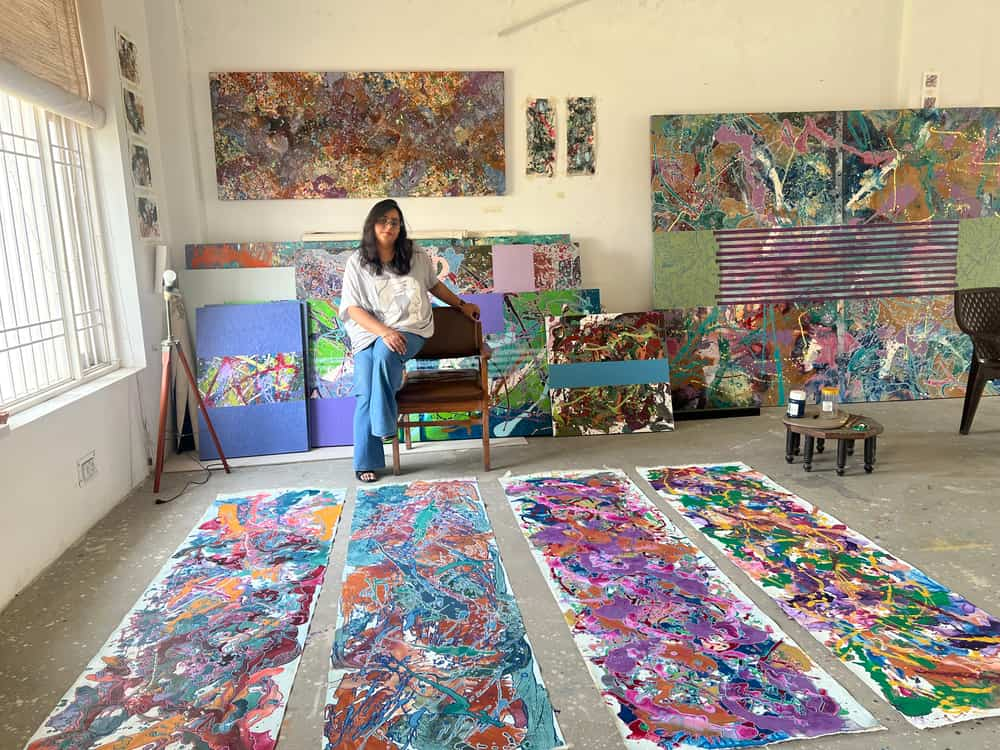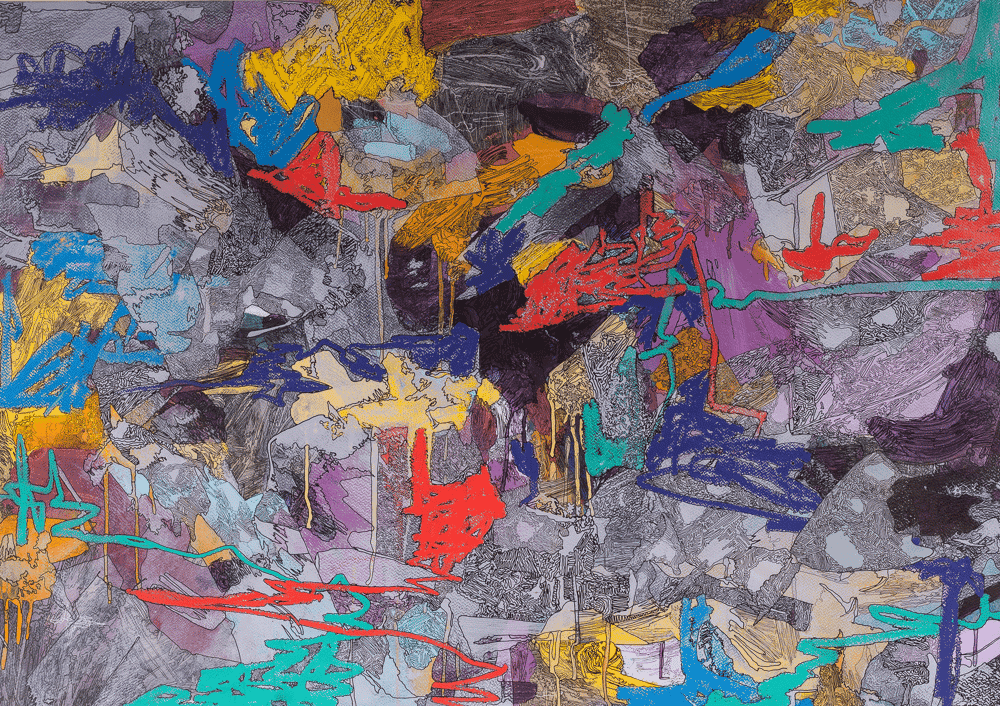#InConversation with Ginni Singh
By Davangi Pathak | Apr 24 2024 · 20 mins
With each brushstroke, Ginni Singh invites viewers to explore the profound within the abstract, encouraging them to discover their own spiritual journeys. As she embarks on a new phase in her artistic life, she remains committed to the boundless world of abstract art, where she continues to craft masterpieces that inspire and awaken the spirit. Through this interaction we will dig deep into Ginni’s journey and how these artworks are a testament to the enduring power of creativity and the limitless potential for self-discovery within the abstract.
Davangi: You started your practice initially with figurative and realism, and later on which shifted to abstract while you were pursuing Masters. Please tell us more about the shift in your practice and the factors that helped you to pursue it further.
Ginni: Transitioning from figurative to abstract art has been a deeply personal journey for me. Initially, my focus in figurative art was on expressing my immediate desires and aspirations, often depicting myself in various scenarios. Over time, as my life evolved, so did my artwork. I began with solitary figures, representing my own emotions and yearnings. Marriage brought about paintings of couples, reflecting the changes in my life. Motherhood further expanded my subject matter, capturing the nuances of familial relationships. Even during my academic pursuits, I initially clung to figurative art, only to realise that I was viewing myself through societal lenses. This realisation sparked a journey of self-discovery, leading me towards abstraction. My paintings now serve as expressions of my innermost thoughts and experiences, guided by a growing understanding of myself. With age and experience, I've come to appreciate the importance of spiritual connection and self-perception. This introspection has broadened my artistic scope, allowing me to explore worldly themes and delve into the realms of spirituality and materialism. Through abstraction, I am able to confront my experiences and translate them into my artwork with depth and meaning.


Ginni Singh at studio


Ginni Singh at studio
Davangi: In our earlier conversation you mentioned that abstract gave you more freedom to express whereas figurative works limited you? Can you please elaborate more about this?
Ginni: When creating figurative or realistic artwork, my brain tends to interpret things very literally, focusing on achieving perfection in every detail. This restricts my creativity because I feel compelled to adhere strictly to the rules of realism. I often become so engrossed in perfecting the drawing or painting that I lose sight of the initial inspiration that drove me to create. Additionally, when it comes to adding colour, my brain imposes certain rules and expectations, limiting my ability to experiment freely. On the contrary, abstract art allows me the freedom to explore without constraints. I approach abstract painting without a predetermined plan, embracing spontaneity with each brushstroke. There are no strict rules to follow, and I am free to break any existing patterns or conventions. This process of building up layers and embracing the unexpected excites me, as it aligns with my belief in living in the present moment without dwelling on the past or worrying about the future. Abstract art represents both my conscious and subconscious mind, allowing me to express myself authentically without feeling constrained by rules or expectations.
Davangi: You were scared of colours, as you stated earlier and as we all can see your body of works comprises “tapestry of vibrant colours”. Please tell us more about this colourful transition.
Ginni: My colour palette used to be extremely limited, primarily sticking to safe and natural colours found in the world around me. I rarely ventured into experimenting with new hues, feeling constrained by my own fear of deviating from the norm. Even in realistic paintings, I found myself hesitant to explore beyond the basic colours, fearing that any deviation would result in muddy, undesirable tones. This limited approach left my artwork feeling disconnected from my vibrant personality, as I am someone who thrives on variety and exploration in all aspects of life. To overcome this artistic stagnation, I delved into colour theory and gradually pushed myself to embrace a wider spectrum of hues. I challenged my fear by deliberately selecting colours I had previously avoided and incorporating them into my artwork. This process was transformative, allowing me to realise that the sky could be any colour, not just the standard blue, and that I had the freedom to represent it in whichever way resonated with me. As I grew more comfortable with experimenting, I began to infuse my paintings with the same vibrancy and uniqueness that characterises my personality. I sought inspiration from art masters and welcomed new colours into my palette with open arms. Just as I gravitate towards vibrant and unconventional choices in my personal style, I began to apply the same principles to my artwork. Now, I find joy in exploring different mediums and techniques, viewing each new discovery as an opportunity for creative expression. No longer confined by fear, I embrace bold and unusual colours, knowing that I have the skill and confidence to balance them harmoniously. My paintings have evolved to reflect the depth and complexity of my personality, with shades of purple often taking centre stage. To me, purple symbolises both transparency and mystery, capable of conveying a range of emotions within a single hue. In essence, my journey with colour has been a process of self-discovery and liberation, allowing me to create artwork that truly speaks to who I am as an individual.
Davangi: Speaking about your process, post painting you add a layer of pen drawing which adds dynamic lines into your composition? Can you elaborate more about your process and making?
Ginni: Working with pens holds deep personal significance for me. I view pens as a universal tool, connecting us all in some way. For me, they symbolise a pivotal moment in my childhood when I transitioned from using pencils to pens in school. This transition marked a significant achievement for me, as it represented a step towards maturity and self-expression. As a child, I struggled to articulate my thoughts and feelings, often feeling overshadowed by more academically successful peers. Drawing became my refuge, my sanctuary where I could be myself without fear of judgement or criticism. It was through drawing that I found a sense of identity and purpose, earning recognition and praise that eluded me elsewhere. In many ways, drawing was akin to crying out for attention, a fundamental human need for validation and acceptance. This need for recognition has remained constant throughout my life, manifesting itself in different forms as I've grown older. The transition to using pens was a turning point for me, symbolising acceptance and validation from the world around me. Even today, the act of selecting a pen fills me with excitement and anticipation. Each pen represents a new opportunity for creativity and self-expression, a chance to reaffirm my identity and worth. I approach pen work with a sense of reverence, as if I'm revisiting my younger self and offering reassurance and encouragement. Drawing with pens is like engaging in a conversation with my past, a way of honouring the journey that has brought me to where I am today. It's a reminder that every layer of my identity, no matter how seemingly insignificant, has contributed to the person I've become. I find solace in the act of drawing straight lines, a reflection of my preference for living in the moment and embracing spontaneity. Rather than meticulously planning every detail, I trust in my instincts and allow the process to unfold organically. In essence, pen work is not just about creating art; it's about reclaiming my voice and asserting my presence in the world. It's a testament to the power of self-expression and the enduring impact of childhood experiences on our sense of self.
Davangi: Whilst pursuing your masters you faced many challenges such as managing balance between art & social life. Would you like to describe your challenge? (Many female artists would like to know your journey and it will be inspiring for them)
Ginni: The challenges I encountered during my master's program were significant, particularly the adjustment of leaving my child at home while attending classes full-time. This was a completely new experience for me, and I was apprehensive about how my child would cope without me. There was the fear of him missing me or feeling upset when I had to leave for college. Adding to the challenge was the fact that my child had recently moved to India from Malaysia, and the transition was not easy for him due to the language barrier. Despite being in India for a year, he was still adjusting to the new environment. Leaving him behind was undoubtedly my biggest hurdle. In India, societal norms often dictate that mothers should prioritise staying at home with their children, and there were whispers and judgments from acquaintances and even some college peers about my decision to pursue my studies. I felt the pressure of societal expectations, with comments insinuating that I was neglecting my duties as a mother.
However, I refused to let these opinions dictate my choices. I reminded myself that times have changed, and women should have the freedom to pursue their goals and ambitions. It was a constant battle against societal norms and expectations, but I knew that pursuing my education was essential for my personal growth and fulfilment. Despite facing criticism and judgement, I had unwavering support from my immediate family, particularly my father-in-law, who encouraged me to follow my heart. He reassured me that they would take care of my child while I focused on my studies. The pressure from society often weighed heavily on me, leading to moments of self-doubt and sacrifice. I found myself cutting back on social interactions and family visits to prioritise my studies. It was a challenging balancing act, juggling between my responsibilities as a daughter-in-law and a student. One of the physical challenges I faced was climbing the stairs to my classroom on the fourth floor, as the lift was reserved for teachers. Despite these challenges, I remained determined to excel in my studies, seeking support from my teachers and classmates along the way. In the end, my college days were a blend of challenges and triumphs. I cherished the opportunity to relive the college experience, grateful for the chance to pursue my passion for art and education. My journey was a testament to resilience and determination, proving that age should never be a barrier to pursuing one's dreams.
Davangi: You don’t plan and paint. Your works are spontaneous in nature. Please tell in depth about your artistic practice & approach.
Ginni: I embrace spontaneity in my painting process, as planning tends to stifle my creativity and authenticity. When I overthink and plan too much, I lose touch with my true artistic expression, and it feels disingenuous. Instead, I trust my instincts and follow wherever my heart leads me, ensuring that I remain true to myself and my emotions. My approach to painting is intuitive; I let my emotions guide me, selecting colours and compositions based on what resonates with me in the moment. I engage in a dialogue with my canvas, listening to its subtle cues and responding accordingly. Each stroke is a reflection of my innermost thoughts and feelings, allowing me to express myself authentically without the need for detailed explanations. There are times when I may have a vague idea of the overall feeling or theme I want to convey in a painting, but I never fully plan it out. Instead, I let the process unfold organically, allowing myself to be surprised by the unexpected twists and turns along the way. This element of surprise keeps me engaged and invigorated, breathing life into my work with each new layer. In life, I hold firm to the belief that as long as we are still breathing, there is hope and opportunity for growth. I draw inspiration from nature, observing how even a seemingly lifeless plant can spring back to life with a little care and attention. Similarly, I approach challenges with resilience and optimism, refusing to give up even in the face of adversity. Recently, I experienced the loss of my father-in-law, a deeply significant moment that reminded me of the fragility of life. While his passing left a void in our lives, I found solace in the knowledge that life must go on. We continue to breathe, to eat, to laugh, and to argue, honouring his memory while embracing the present moment. In my painting process, I strive to capture this essence of life—the resilience, the beauty, and the ever-present possibility of renewal. Each brushstroke is a testament to the power of the human spirit, a celebration of life in all its complexity and wonder. I may not always know where the journey will take me, but I trust in the process and the wisdom of my subconscious to guide me forward.
Davangi: Would you like to mention any of your favourite/idol artists or practitioners that you look forward to?
Click here to view Ginni's Online Viewing Room and learn more about her practice.
Ginni: When it comes to my favourite artists, the world is filled with talent. I admire a variety of artists for the unique perspectives they offer, such as Prabhakar Kolte, Gopi Gajwani, Anjolie Ela Menon, Mithu Sen, and Amrita Shergill. In the realm of foreign artists, Jean-Michel Basquiat, Mark Rothko, Wassily Kandinsky, Willem de Kooning, Jackson Pollock, and Michelle Muller catch my attention. Each artist brings something distinct to the table. For instance, Anjolie Ela Menon’s work captivates me with its simplicity, reflecting the essence of everyday Indian life. Prabhakar Kolte’s art surprises me with its freedom and boldness, while Gopi Gajwani's pieces mirror his calm and composed nature.
Hukum Lal Singh's colour palette and composition thrill me, offering a balanced and harmonious visual experience. Mithu Sen's work offers a fresh perspective on the world, while Amrita Shergill's paintings poignantly capture the struggles of Indian women. Among foreign artists, Jackson Pollock's uninhibited expression and Rothko's emotional depth resonate deeply with me. Michelle Muller's serene compositions and innovative use of glass frames intrigue me, adding a mystical dimension to her work. Basquiat's works exhilarate me to the core. It's astounding how an artist can be so uninhibited, unafraid, and convey so much meaning in a single painting. Each artist serves as a source of inspiration, evoking different emotions and encouraging introspection. Their diverse techniques and experiences make them invaluable teachers, offering endless lessons to anyone who appreciates art.
Davangi: Would you like to tell us about any future projects? Will you be experimenting with different mediums?
Ginni: As an abstract artist, I'm excited to delve into future projects that explore the concept of three-dimensional surfaces. I find the idea of manipulating space and texture to be incredibly intriguing and inspiring. Additionally, I'm eager to experiment with a variety of mediums to further express my artistic vision. For me, the medium is not just a tool but also a muse, guiding and inspiring my creative process. By exploring different mediums, I hope to push the boundaries of my artistry and discover new ways to convey emotion and meaning in my work. So, yes, I definitely plan to experiment with different mediums in my future projects.


